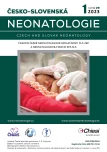Craniosynostosis
Authors:
R. Richterová; G. Mičurová; R. Opšenák; B. Kolarovszki
Authors‘ workplace:
Neurochirurgická klinika, Jesseniova lekárska fakulta UK a Univerzitná nemocnica, Martin
Published in:
Čes-slov Neonat 2023; 29 (1): 70-76.
Category:
Reviews
Overview
The term craniosynostosis refers to a developmental craniofacial anomaly that originates as a result of the premature closure of one or more cranial sutures. This condition subsequently leads to a deformity of the skull, depending on the suture that was affected by the premature fusion, and can also cause a restriction in the physiological development of the brain. This can be manifested by a chronic slight increase in intracranial pressure, headaches, but also a delay in psychomotor development, speech development disorders and, in school age, reduced intellectual performance and difficulties in social interaction. In this article, we describe natural development of cranial sutures, but also discuss their premature closure, offer an overview of the basic types of craniosynostosis, the possibilities of diagnostics and treatment. We also present the case patient with metopic suture synostosis who underwent surgical treatment at our department.
Keywords:
surgical treatment – craniosynostosis – cranial sutures – premature fusion
Sources
1. Jha RT, Magge SN, Keating RF. Diagnosis and surgical options for craniosynostosis. In: Ellenbogen RG et al. Principles of neurological surgery (4th ed). Amsterdam: Elsevier 2018; 148–169.
2. Beederman M, Farina EM, Reid RR. Molecular basis of cranial suture biology and disease: osteoblastic and osteoclastic perspectives. Genes and Diseases 2014; 1 (1): 120–125.
3. Kajdic M, Spazzapan P, Velnar T. Craniosynostosis – recognition, clinical characteristics and treatment. Bosn J Basic Med Sci 2018; 18 (2): 110–116.
4. Ruengdit S, Case DT, Mahakkanukrauh P. Cranial suture closure as an age indicator: a review. Forensic Sci Int 2020; 307 (110111).
5. Krakow D. Craniosynostosis. In: Obstetric imaging: fetal diagnosis and care (2nd ed). Amsterdam: Elsevier 2018; 301–304.
6. Cornelissen M, Ottelander BD, Rizopoulos D, et al. Increase of prevalence of craniosynostosis. J Craniomaxillofac Surg. 2016; 44(9): 1273–1279.
7. McKusick and Hamosh. Online mendelian inheritance in man (OMIM): an online catalog of human genes and genetic disorders. www.omim.org [cit. 2023-02-10]
8. Yapijakis Ch, Pachis N, Sotiriadou T, et al. Molecular mechanisms involved in craniosynostosis. In Vivo 2023; 37(1): 36–46.
9. Johnson D, Wilkie AO. Craniosynostosis. Eur J Human Genet 2011, 19(4): 369–376.
10. Gedzelman E, Meador KJ. Antiepileptic drugs in women with epilepsy during pregnancy. Ther Adv Drug Saf 2012; 3(2): 71–87.
11. Sanchez-Lara PA, Carmichael SL, Graham Jr JM, et al. Fetal constraint as a potential risk factor for craniosynostosis. Am J Med Genet A 2010; 152A(2): 394–400.
12. Derderian CA. Discussion: Minimally invasive, spring-assisted correction of sagittal synostosis. Technique, outcome and complications in 83 cases. Plast Reconstr Surg. 2018; 141(2): 434–436.
13. Dempsey RF, Monson LA, Maricevich RS, et al. Nonsyndromic craniosynostosis. Clin Plast Surg. 2019; 46(2): 123–139.
14. Van der Meulen J. Metopic synostosis. Childs Nerv Syst. 2012; 28(9): 1359–1367.
15. Diab J, Anderson PJ, Moore MH. Late presenting bilateral squamosal synostosis. Arch Craniofac Surg. 2020; 21(2): 106–108.
16. Lipina R, Rosický J, Golová Š. Léčba polohového plagiocefalu pomocí kraniální remodelační ortézy. Pediatr. Prax. 2014; 15(5): e22–e25.
Labels
Neonatology Neonatal NurseArticle was published in
Czech and Slovak Neonatology

2023 Issue 1
Most read in this issue
- Craniosynostosis
- Diagnostic dilemmas in neonatal meningitis
- Current perspective on the issue of neonatal seizures
- Appropriate management of procedural pain in newborn infants
